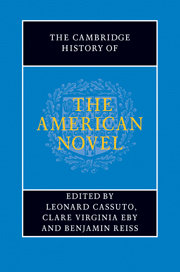Book contents
- Frontmatter
- General Introduction
- PART ONE INVENTING THE AMERICAN NOVEL
- Introduction: inventing the American novel
- 1 Transatlantic currents and the invention of the American novel
- 2 Susanna Rowson, Hannah Webster Foster, and the seduction novel in the early US
- 3 Charles Brockden Brown and the novels of the early republic
- 4 The novel in the antebellum book market
- 5 American land, American landscape, American novels
- 6 Cooper and the idea of the Indian
- 7 The nineteenth-century historical novel
- 8 Hawthorne and the aesthetics of American romance
- 9 Melville and the novel of the sea
- 10 Religion and the nineteenth-century American novel
- 11 Manhood and the early American novel
- 12 Sentimentalism
- 13 Supernatural novels
- 14 Imagining the South
- 15 Stowe, race, and the antebellum American novel
- 16 The early African American novel
- PART TWO REALISM, PROTEST, ACCOMMODATION
- PART THREE MODERNISM AND BEYOND
- PART FOUR CONTEMPORARY FORMATIONS
- A selected bibliography
- Index
15 - Stowe, race, and the antebellum American novel
from PART ONE - INVENTING THE AMERICAN NOVEL
Published online by Cambridge University Press: 28 July 2011
- Frontmatter
- General Introduction
- PART ONE INVENTING THE AMERICAN NOVEL
- Introduction: inventing the American novel
- 1 Transatlantic currents and the invention of the American novel
- 2 Susanna Rowson, Hannah Webster Foster, and the seduction novel in the early US
- 3 Charles Brockden Brown and the novels of the early republic
- 4 The novel in the antebellum book market
- 5 American land, American landscape, American novels
- 6 Cooper and the idea of the Indian
- 7 The nineteenth-century historical novel
- 8 Hawthorne and the aesthetics of American romance
- 9 Melville and the novel of the sea
- 10 Religion and the nineteenth-century American novel
- 11 Manhood and the early American novel
- 12 Sentimentalism
- 13 Supernatural novels
- 14 Imagining the South
- 15 Stowe, race, and the antebellum American novel
- 16 The early African American novel
- PART TWO REALISM, PROTEST, ACCOMMODATION
- PART THREE MODERNISM AND BEYOND
- PART FOUR CONTEMPORARY FORMATIONS
- A selected bibliography
- Index
Summary
In her 1892 novel Iola Leroy, the African American writer and activist Frances E. W. Harper has one of her characters, Dr. Latimer, encourage another, Iola Leroy, to write “a book to inspire men and women with a deeper sense of justice and humanity.” When Iola doubts both her ability and the receptiveness of readers to a black woman's writings, Dr. Latimer responds, “Miss Leroy, out of the race must come its own thinkers and writers. Authors belonging to the white race have written good racial books, for which I am deeply grateful, but it seems to be almost impossible for a white man to put himself completely in our place. No man can feel the iron which enters another man's soul.” Prominent among those white writers who wrote influuential “racial books” was Harriet Beecher Stowe, whose 1852 novel Uncle Tom's Cabin Harper admired deeply. In writing Iola Leroy, a novel that leads to a call for black novelists, Harper was participating in a tradition with deep roots in the period before the Civil War when writing about race increasingly meant writing about black Americans, and when literature about race was complexly intertwined with competing notions of social order, justice, and humanity. At stake in this tradition are not only thorny questions about novelistic authority and authorial authenticity but also fundamental questions about how race might be represented in literature. These questions, too, are deeply rooted in the antebellum period, and the effects of this earlier period of literature influenced greatly what Robert Reid-Pharr characterizes in this volume as the “shockingly discordant cacophony of form, theme, content and style” that one encounters in post-Civil War novels that deal explicitly with race.
- Type
- Chapter
- Information
- The Cambridge History of the American Novel , pp. 252 - 266Publisher: Cambridge University PressPrint publication year: 2011



